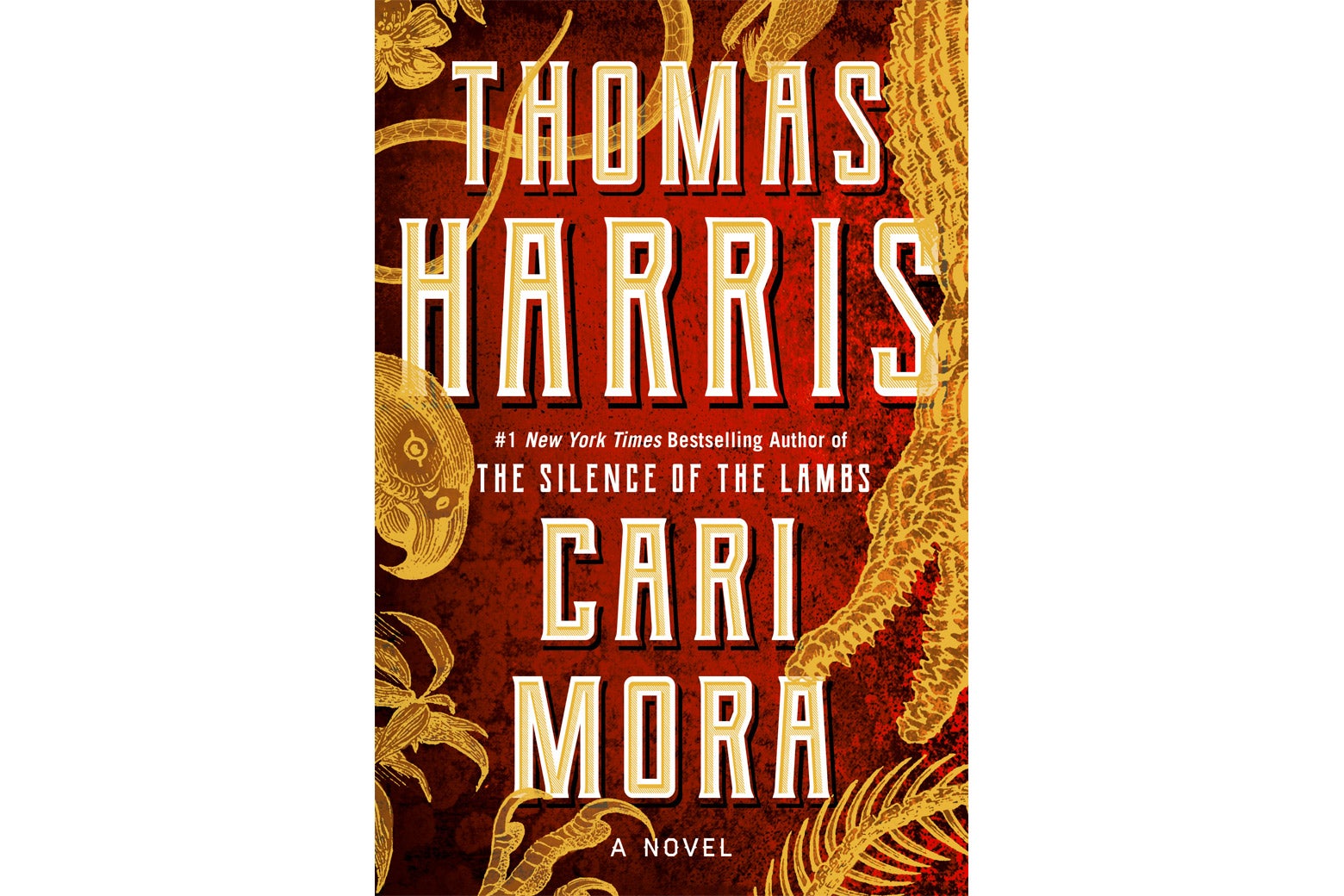Four decades ago, Thomas Harris invented the serial killer thriller and—fittingly, perhaps—trapped himself in a dungeon of his own design. Serial killers had occasionally cropped up in fiction before 1981’s Red Dragon, but with that novel, Harris set up the formula that we now know all too well: an evil genius who leaves a trail of bodies distinguished by a grisly signature; a detective who tries to catch the fiend by figuring out how he thinks, often to his or her own psychological harm; a cat-and-mouse game between the murderer and the authorities; and, finally, once the clues have been pieced together, the desperate race to keep the killer from claiming a final victim, all culminating in a showdown with the hero.
Like Hannibal Lecter locked up in a windowless high-security prison, Harris became a captive. Every novel he’s published after Red Dragon has been about Lecter. He produced a sequel, The Silence of the Lambs, in 1988; Jonathan Demme’s film version, starring Anthony Hopkins as Lecter, made the cannibal psychiatrist into a pop culture icon for whom audiences were insatiable. Those first two novels are masterfully plotted, with just enough brooding detail to disguise how thinly the characters are sketched—in other words, exemplars of the thriller form. But the two that followed, Hannibal and Hannibal Rising, feel contrived and forced, overripe with campy flourishes and scenes that beg to be narrated by Vincent Price. The frighteningly suave psychopath Lecter became a man-eating antihero with a sympathetic backstory and an appetite for the finer things in life as well as for human flesh. Ultimately, his erudition and refinement get him the girl. The late film producer Dino De Laurentiis told Entertainment Weekly that Harris only wrote Hannibal Rising under duress in 2006 because De Laurentiis threatened to make another movie about the character without Harris’ input, undermining his copyright.
Now, at last, Harris has found his way out of the Lecter straitjacket. Cari Mora, his first novel in 13 years, features no demented representatives of the therapeutic professions or strong-jawed FBI agents tussling with their venal superiors. Within the first 20 pages, however, Harris introduces his readers to Hans-Peter Schneider, who is German, completely hairless (including eyelashes), and owns both a white latex plugsuit and a liquid cremation machine. But wait, there’s more! Hans-Peter also specializes in abducting and mutilating women to sell to a network of wealthy amputee fetishists in Mauritania. And he enjoys revisiting the secreted corpses of his discarded victims to observe how they have been “warmed wonderfully—warmed warmer than life by the larval mounds” of insects. In his dastardly sadism, Hans-Peter rivals Hannibal’s Mason Verger, a pedophile who, despite being paralyzed from the neck down and missing a face (Lecter once drugged him and persuaded him to cut it off and feed it to his dogs), still keeps a hand in the game. Verger’s hobby is taunting small children until they cry so that an aide can harvest their tears to add to Verger’s cocktails.
Cari Mora is by no means all camp. When he’s not out-eviling Doctor Evil, Hans-Peter pursues more mundane sources of income. Most of the Miami-set novel concerns the rivalry between two criminal gangs: scumbag mercenaries hired by Hans-Peter and a band of noble Latinos in the employ of Don Ernesto—who is basically Mario Puzo’s Don Corleone in Colombian drag. Harris’ bad guys come in two tiers. There are the secretly admirable, like Lecter, who for all their many crimes nevertheless maintain a code (Lecter only kills what he calls the “free-range rude”). And then there are the truly despicable, who can be identified by their freakish physical appearance: Verger’s horrible visage, or the cleft lip of Francis Dolarhyde, the serial killer in Red Dragon. Hans-Peter’s hairlessness makes him one of Harris’ monsters. Don Ernesto, with his courtly manners, fine suits, and fidelity to his word, belongs to the former group.
Both gangs are after a stash of gold bars hidden somewhere in a seaside Miami villa once owned by Pablo Escobar. They want to get it out of the house and the country without alerting the local or federal authorities, but their efforts are hampered by the hefty payload of plastic explosives mining the loot. Also, there is a saltwater crocodile who makes an impressive early appearance by biting one of the mercenaries in half but does not, I feel, get properly paid out as a plot complication. (Chekhov’s gun applies to semiaquatic reptiles, too.) Otherwise, though, the heist story that makes up the bulk of Cari Mora is inventive and crisp, with a prose style that owes less to the floridness of the last two Hannibal novels than it does to the late and much-lamented Elmore Leonard:
Candy drove the lunch truck onto the wharf. She parked and got out.
Candy wore short shorts and a blouse tied at the midriff. She’s looking good.
She called up to Flaco on the bridge of the ship, “Hey, I got hot empanadas.”
“True that,” Flaco said to himself.
The novel is named after its heroine, a former child soldier for FARC who, like Clarice Starling, is haunted by memories of the torment and slaughter of innocents. Unlike Starling, Cari Mora has modest ambitions; she wants to stay in the U.S., become a veterinarian, and buy a repo’ed cottage with a mango tree in the backyard. She’s in Miami, as Don Ernesto puts it, “by the skin of her teeth with a Temporary Protected Status. The US president could cancel everyone’s TPS at any moment in a fit of pique, if the president knew what a TPS was.” Although not a criminal herself (she volunteers at a bird sanctuary), Cari is friendly with the Don’s crew, and more importantly, she is the caretaker of the villa where the treasure is hidden. Once Hans-Peter gets an eyeful of her, he starts making plans to “customize” her for sale to a Mauritanian client after he secures the gold. (Why this fixation on Mauritania, you may be wondering? Well, the West African nation has been justly condemned for its tacit condoning of modern-day slavery. But I’m going to go out on a limb here and say that its population of fabulous wealthy, sadistic amputee fetishists is probably a lot smaller than Harris suggests.)
In his excellent 2008 book, Hard-Boiled Sentimentality: The Secret History of American Crime Stories, Leonard Cassuto pointed out that the serial killer thriller as formulated in Red Dragon departed from what we know about actual serial killers in an import respect: Real serial killers usually target individuals made vulnerable by their marginal social status—prostitutes, the poor or homeless, drifters. Francis Dolarhyde, by contrast, chooses his victims in the course of his work in a film lab, selecting literally picture-perfect white, middle-class nuclear families from the home movies they send in for development.
The serial killer became America’s boogeyman of choice in the 1980s partly for historical reasons. In the 1960s and ’70s, Ted Bundy and John Wayne Gacy were arrested after breaking the mold and murdering white, middle-class victims, thereby attracting a great deal of media attention. In 1972, the FBI established its Behavioral Science Unit to gather information on the psychology of criminals, particularly serial rapists and murderers, and inadvertently provided grist for countless thrillers with profiler heroes. Harris based the detective in Red Dragon on the FBI profiler John Douglas (whose autobiography is the basis for the Netflix series Mindhunter). Cassuto also argues that the fictional serial killer’s choice of victims makes him “the ultimate anti-family” man, who “stands opposite the modern domestic detective, who is the idealized family’s most ardent defender.” If Ronald Reagan’s presidency was a political reaction to the disruptive social changes of the 1960s and ’70s, the serial killer thriller was Reaganism’s psychosexual counterpart, the pop culture id of the 1980s. Both promised that terrifying chaos agents who reject conventional restraints and categories can ultimately be subdued and everyone sorted back into his or her proper role.
Slate has relationships with various online retailers. If you buy something through our links, Slate may earn an affiliate commission. We update links when possible, but note that deals can expire and all prices are subject to change. All prices were up to date at the time of publication.
The maniacs in Harris’ first two Hannibal novels don’t just want to kill people; they are intent on transforming themselves into new beings: Dolarhyde, inspired by a William Blake painting, wants to become a powerful creature he calls “the Red Dragon.” Buffalo Bill, in The Silence of the Lambs, is making a “girl suit out of real girls” so that he can become his own mother. (Transgender activists have justly voiced much criticism of this depiction, although both book and film stress that Bill is not a “real transsexual,” whatever Harris means by that.) And while the Satanic Lecter remains a gentleman, like the other killers in these books (and the counterculture of the late 20th century) he refuses to restrain his unholy appetites, not least of which is his desire to get stoic FBI agents to talk about their feelings.
Whether or not Harris ever consciously endorsed the anxieties expressed by the genre he created (he hasn’t granted an interview since the ’70s), Cari Mora represents a bid for a more liberal worldview. The novel makes multiple digs at the Trump administration’s immigration policies, and all of the good characters are people of color. (Hans-Peter is technically a Paraguayan national, suggesting that he’s descended from Nazis who fled to Latin America after World War II.) Sexuality still represents a monstrous threat and a potential source of corruption and danger, however; Harris’ fiction offers few depictions of nondestructive physical love. Cari Mora, like Clarice Starling (at least until the end of Hannibal, when she surrenders to the charms of Lecter), is notably chaste. The grotesque inhumanity of Hans-Peter’s lusts feels like a crutch for Harris, a reliable method of ratcheting up the stakes and delivering the morbid chills his audience has come to expect. What sort of diverting heist novel would Cari Mora be without it? I found myself wondering. What if Cari Mora got herself a nice, nonhomicidal girlfriend or boyfriend and felt a bit of joy for a change? Probably too much to ask. Take her name, for one: Swap the last letters of her given and surname and you get Cara Mori, Latin for “Dear Death,” a barely concealed ransom note from all the baroquely grotesque murders and unspeakable desires that made Harris’ fortune and reputation. He’s not quite free yet.

